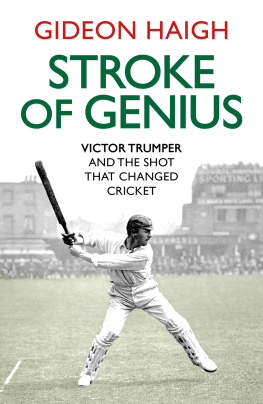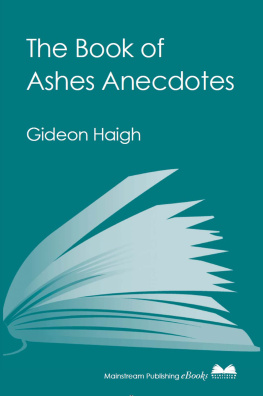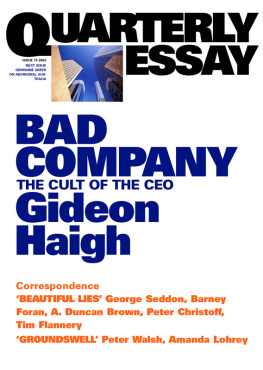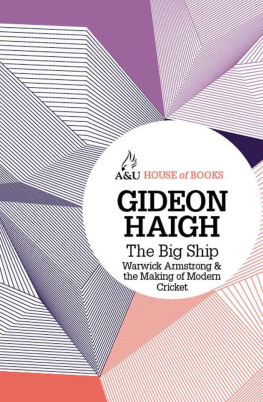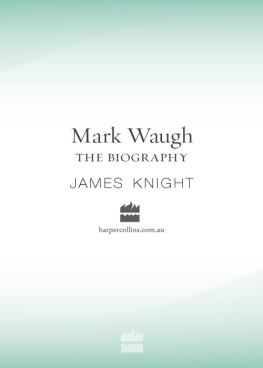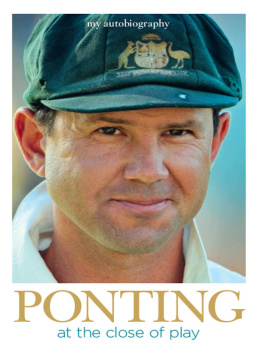ABOUT THE AUTHOR
Gideon Haighs other books for Aurum include accounts of the last two Ashes series, Ashes 2005 and Downed Under (200607); Mystery Spinner, his biography of the forgotten Australian Test spinner Jack Iverson, which was voted Cricket Society Book of the Year, shortlisted for the William Hill Sports Book of the Year and hailed as a classic by the Sunday Times; The Big Ship, his biography of the Australian Test captain Warwick Armstrong, whose side achieved the 1920s Ashes whitewash; Many a Slip, his diary of a club cricket season; and Peter the Lords Cat, his collection of the most unexpected and eccentric obituaries from the pages of Wisden Cricketers Almanack. He covered the last two Ashes series for the Guardian, Wisden Cricketer and cricinfo.com. He lives in Melbourne, Australia.
The star writer of the moment and the latest in a blue-blooded lineage, reaching back to Neville Cardus through C.L.R. James and Matthew Engel, whose allusions soar beyond the boundaries of normal cricket journalism into music, politics and literature. Haighs analyses are brilliant.
CHRISTOPHER DOUGLAS, WISDEN CRICKETER

First published in 2008
by Aurum Press Ltd, 7 Greenland Street, London NW1 0ND
Published by arrangement with Black Inc., an imprint of Schwartz Publishing Pty Ltd
This ebook edition first published in 2012
All rights reserved
Gideon Haigh, 2007
The right of Gideon Haigh to be identified as author of this work has been asserted in accordance with Section 77 of the Copyright, Designs and Patents Act 1988
This ebook is copyright material and must not be copied, reproduced, transferred, distributed, leased, licensed or publicly performed or used in any way except as specifically permitted in writing by the publishers, as allowed under the terms and conditions under which it was purchased or as strictly permitted by applicable copyright law. Any unauthorised distribution or use of this text may be a direct infringement of the authors and publishers rights, and those responsible may be liable in law accordingly
ISBN 978-1-84513-839-4
INTRODUCTION
The (Green and) Gold Standard
Cricket is hardly alone in having a golden age; there are golden ages in cultural phenomena from comic books and detective fiction to arcade games and dancehall music. Cricket, though, is uncommonly susceptible to golden age thinking: the cast of mind that burnishes past time and character, usually to the detriment of the present. It has an outsized sense of inheritance and tradition; it has pauses and longueurs that invite reflection and reminiscence; it requires a time and space that savours of past luxuries, of peace and of plenty.
As the owner of a cat called Trumper, Im hardly entitled to denounce this thinking. On the other hand, it is as much a trap as the assumption that all is for the best in this best of all possible worlds. The blessings of this era are abundant and manifest. If youre an Australian, this last decade has been as good as it gets, a pageant of success, with just enough disappointment along the way to make the highlights worth cherishing; a procession of players as good as any ever seen, including a trio of first-rate captains in Mark Taylor, Steve Waugh and Ricky Ponting. Shane Warne or Glenn McGrath or Adam Gilchrist could have defined an era on their own. I wonder sometimes if the rest of my cricket-watching life is not going to be rather anti-climactic.
Like any belle poque, this one has also known its discontents, some transitory, some abiding to the extent, indeed, that it has sometimes felt like a relief to write about cricket, rather than politics, commerce, corruption, or all three at once. On the other hand, Ive never felt this a useless process. An era defines itself not only by its deeds, but by what it wont stand for. No issue has shocked me more than match-fixing. I recall the satisfaction with which I wrote in the first edition of The Cricket War (1993): No team has yet thrown a game. I recall the disgust with which I had to cut the line from the second edition in 2000. All the same, it was consoling that many people shared that disgust; that, amid so much contrivance and so many cheap thrills in sport, crickets integrity still mattered.
Thus this book, The (Green &) Golden Age, which samples some of my writings since 1997 on modern cricket and cricketers, mainly Australian. It is a record of the achievements and dissatisfactions of the moment, most of the pieces having been written quickly, to tight word limits and deadlines, for papers, magazines, books and blogs. The first was written on the day Mark Taylor retired; the last to plug a late-opening hole in Inside Sport. There is the short piece I composed for the Australian on the day that Warne and Mark Waugh admitted their misadventures with John the Bookie I can still remember my shock and sorrow. There are some match reports for the Guardian from 2005s Super Series, which was like being sent to review Plan 9 from Outer Space. There are interviews, blog posts, columns and critiques, including of Steve Waughs 2-kilogram autobiography, which I had a weekend to read then describe in 1400 words the things I do for cricket
In some ways, if it doesnt sound pretentious, it is also a record of the genre, of the different ways we are increasingly challenged to write about cricket in particular and sport in general. The coverage of sport is one area in which newspapers and magazines have improved radically over the last twenty-five years; it is broader and deeper and richer and more varied than when I took my first steps in the trade. There is too much, of course hell, there is too much of everything. And if youre not bored occasionally in this line of work, youre probably lacking imagination. But creatively, analytically, technologically, professionally, these are good days to be a journalist in sport as good, in fact, as they are bad in other areas. Find yourself a paper or a cricket magazine from 1982 and see if you dont agree with me. The past wasnt all Cardus and Ray Robinson. There were always plenty of ghosted columns, and none of them was as unintentionally funny as Steve Harmisons.
I can genuinely thank my editors for The (Green &) Golden Age; without them, none of it would have been written. They include David Frith, Stephen Fay, John Stern, Christian Ryan, Sambit Bal, Graem Sims, Sally Warhaft, Ben Clissitt and Adam Sills. Latterly, it was a pleasure to work with Chris Feik, Morry Schwartz, Denise ODea and their Black Inc. colleagues. The (Green &) Golden Age is dedicated to Jim Schembri and Wendy Tuohy: friends since our first day as reporters together.
Gideon Haigh
Melbourne 2007
THE BAGGY GREEN MACHINE
MARK TAYLOR
Safe Hands
Does no-one have a bad word to say about him? an English cricket journalist asked me of Mark Taylor a month or so ago. He was genuinely baffled that anyone, especially in the squalid and scandal-wracked world of sport, could be so uniformly respected and bereft of enemies.
It was impossible to enlighten him. Taylor may have his flaws. He does seem to chew with his mouth open. He may not floss regularly. Yet Australias thirty-ninth captain and its latest Australian of the Year is assuredly a rare figure, even among athletes. Cricketers in Australia have been admired, revered, even worshipped. Seldom have they been so plainly and completely liked, as sportsman and as civilian.
Taylor led Australia in fifty consecutive Tests and to twelve series victories in fifteen starts, including three Ashes rubbers; he oversaw, too, the recapture and retention of the Frank Worrell Trophy. If his form was spasmodic over the past three years, he was at the conclusion of his career the highest-scoring Test batsman still playing, at a time when international new ball talent was abundant. In his first year in Test cricket, he absorbed bowling like a black hole absorbs light, averaging 70 in his initial fourteen Tests. If he regressed to the mean in his remaining ninety Tests, he still averaged a handy 40 doing so. He was also one of the outstanding slip fielders of his generation, with a simple technique and flypaper palms.
Next page


